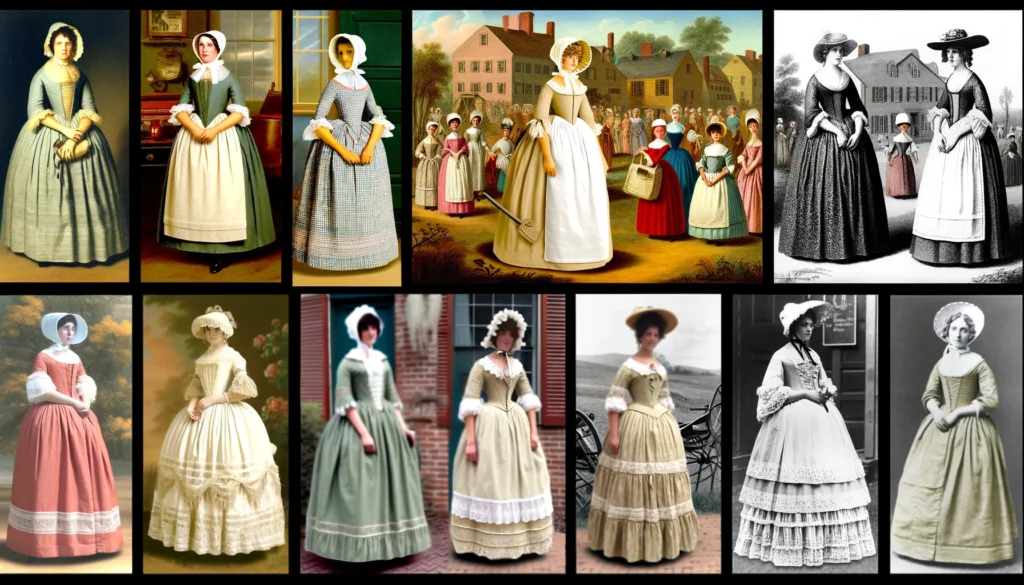Traditional American clothing for women is a rich tapestry of styles, fabrics, and influences that reflect the diverse cultural heritage of the United States. From the early colonial period to the 19th century, the evolution of women’s attire in America tells a fascinating story of adaptation, innovation, and identity. This article explores the various traditional clothing styles worn by American women throughout history, examining the social, economic, and cultural factors that influenced their fashion choices. To buy Women’s Dresses visit MotherBrideDress.com
Traditional American Clothing for Women
Colonial Era (1600s-1700s)
Early Settlers and Native Influence
The early American colonial period was marked by a blend of European and Native American influences. European settlers brought their traditional clothing styles, but the harsh conditions of the New World required practical adjustments. Women’s clothing during this period was utilitarian, designed to withstand the rigors of frontier life.
The typical attire for women included long, modest dresses made from wool, linen, or cotton. These dresses featured high necklines, long sleeves, and full skirts that provided coverage and protection. Pinafores and aprons were commonly worn over the dresses to keep them clean during daily chores.
Native American clothing also influenced early settlers, particularly in terms of materials and techniques. For example, buckskin and fur became popular for their durability and warmth. Native styles of embroidery and beadwork began to appear in some colonial garments.
Puritan Influence
In New England, the Puritans, known for their austere lifestyle, wore clothing that reflected their religious beliefs. Puritan women’s clothing was plain and modest, often in dark colors such as black, brown, and dark green. Decorative elements were minimal, and accessories like lace and jewelry were considered frivolous. The focus was on simplicity and modesty, with garments designed to cover the body fully.
18th Century: The Revolutionary Period
Georgian Influence
During the 18th century, American women’s fashion began to reflect the styles popular in Europe, particularly those from England. The Georgian period saw the introduction of more elaborate and decorative clothing. Women wore gowns with fitted bodices, elaborate skirts supported by petticoats, and often, hoop skirts. Fabrics such as silk, satin, and brocade became more accessible to the wealthy, allowing for more luxurious attire.
Bodices were often adorned with lace, ribbons, and embroidery. The necklines became lower and more rounded, and sleeves were generally elbow-length. Accessories such as fichus (triangular scarves), bonnets, and gloves were also common.
The Impact of the Revolution
The American Revolution (1775-1783) brought significant changes to women’s fashion. Patriotism influenced clothing choices, with women adopting homespun fabrics to support the war effort and boycott British goods. The emphasis was on practicality and frugality, with simpler designs becoming more common.
Early 19th Century: Regency and Empire Styles
Regency Influence
The early 19th century saw the influence of Regency fashion from England. Women’s clothing during this period was characterized by high-waisted Empire gowns with short sleeves and low necklines. These dresses were often made from lightweight fabrics such as muslin, which draped gracefully over the body.
The simplicity of Regency fashion was a departure from the elaborate styles of the 18th century. The focus was on a natural silhouette, with minimal decoration. Shawls, gloves, and bonnets continued to be popular accessories.
Westward Expansion and Pioneer Clothing
As America expanded westward, women’s clothing adapted to the challenges of frontier life. Pioneer women needed durable and practical clothing that could withstand the demands of travel and homesteading.
Dresses were made from sturdy fabrics like cotton and wool, often in simple, functional designs. Aprons, bonnets, and shawls provided additional protection from the elements. Layering was essential, with women wearing multiple petticoats and undergarments to stay warm during cold winters.
Mid to Late 19th Century: Victorian Influence
The Victorian Era
The Victorian era (1837-1901) brought significant changes to women’s fashion in America. The early Victorian period was characterized by wide skirts supported by crinolines or hoops, creating a bell-shaped silhouette. Bodices were fitted and often featured high necklines and long sleeves. Fabrics such as silk, velvet, and taffeta were popular, and garments were richly decorated with lace, ribbons, and embroidery.
By the mid-19th century, the silhouette changed again with the introduction of the bustle, which added volume to the back of the skirt. This period also saw the rise of the sewing machine, making it easier to produce elaborate garments at home.
The Influence of Industrialization
Industrialization had a profound impact on women’s clothing in the late 19th century. Mass production made fashionable clothing more accessible to a broader population. Ready-to-wear garments became available, allowing women to keep up with the latest trends without needing to sew their own clothes.
The Gibson Girl, an iconic image created by illustrator Charles Dana Gibson, epitomized the ideal American woman of the late 19th century. The Gibson Girl was independent, educated, and fashionable, often depicted wearing tailored shirtwaists (blouses) and skirts. This style was both practical and stylish, suitable for the increasing number of women entering the workforce and participating in outdoor activities.
Traditional American Clothing: Regional Variations
Southern Belle
In the southern United States, the antebellum period before the Civil War was marked by the iconic Southern Belle style. Women wore elaborate, voluminous dresses with wide skirts supported by crinolines. These dresses were often made from luxurious fabrics like silk and featured intricate details such as lace and ruffles. The look was completed with wide-brimmed hats, gloves, and parasols.
Native American Influences
Native American women’s traditional clothing varied widely among different tribes but often included beautifully crafted garments made from natural materials like buckskin, wool, and cotton. These garments were decorated with intricate beadwork, quillwork, and embroidery. In some regions, women wore dresses made from deer or elk hides, adorned with fringe and symbolic designs.
The Influence of Immigrant Communities
Immigrant communities brought their traditional clothing styles to America, enriching the cultural tapestry. For example, German, Scandinavian, and Eastern European settlers brought distinctive styles that influenced local fashions. In areas with large immigrant populations, traditional garments such as dirndls, peasant blouses, and folk dresses were adapted to American sensibilities.
Traditional American clothing for women is a testament to the nation’s diverse cultural heritage and the adaptability of its people. From the practical and modest attire of the early settlers to the elaborate fashions of the Victorian era, each period in American history has left its mark on women’s fashion. Regional variations and the influence of immigrant communities further enriched the styles and traditions that make up the tapestry of American clothing.
Today, while modern fashion often draws inspiration from these historical styles, the traditional clothing of American women remains a fascinating reflection of the country’s evolving identity. As we look back at the garments of the past, we gain a deeper appreciation for the ingenuity, creativity, and resilience of the women who wore them.



